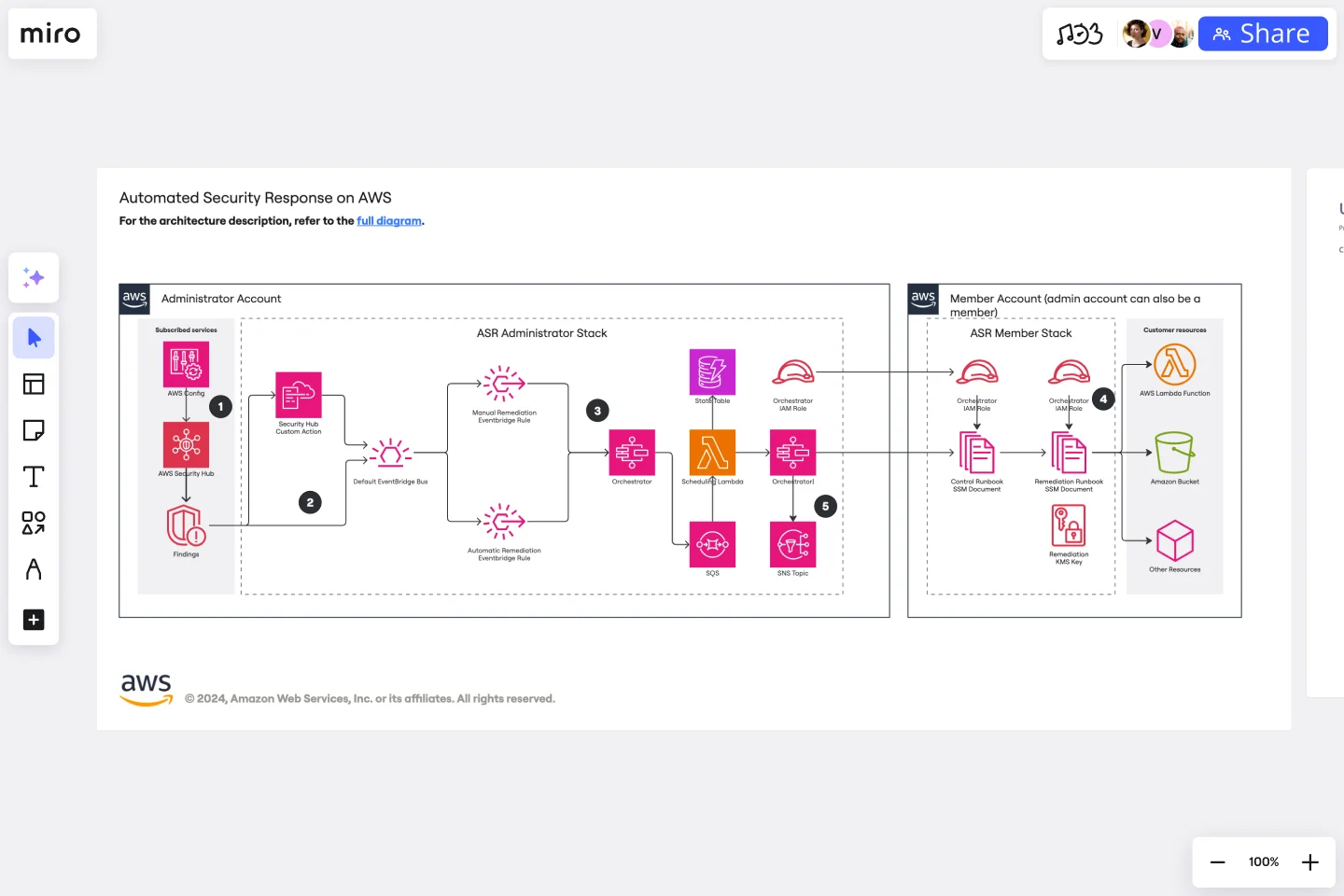Automated Security Response on AWS Template
Use the Automated Security Response on AWS template to improve AWS security by automating the detection and response to security threats, ensuring minimal manual intervention, and safeguarding infrastructure against evolving threats.
Available on Enterprise, Business, Education plans.
About the Automated Security Response on AWS Template
The Automated Security Response on AWS template is a strategic tool designed to enhance the security posture of AWS environments. This template facilitates the automated response to security incidents, ensuring that potential threats are swiftly identified and mitigated with minimal manual intervention. By using AWS's robust security services and features, the template allows for the creation of a responsive and resilient security framework.
How to use the Automated Security Response on AWS Template in Miro
Customization: Once the template is opened in Miro, you can customize it according to your specific AWS environment and security requirements. The template is designed to be flexible, allowing for adjustments to fit various security scenarios.
Integration with AWS: For the template to function effectively, integrate it with your AWS account. This involves setting up AWS Lambda functions, Amazon CloudWatch Events, and other AWS services that the template utilizes to automate security responses.
Simulation and testing: Before deploying the template in a live environment, simulate security incidents to test the automated responses. This ensures that the template is configured correctly and can handle real-world security threats.
Deployment: After thorough testing and customization, deploy the template to start automatically monitoring and responding to security incidents in your AWS environment.
Continuous improvement: Regularly review the automated responses triggered by the template and make necessary adjustments. Security threats evolve, and so should your automated responses to stay ahead.
Why use the Automated Security Response on AWS Template
Enhanced security: Automates the detection and response to security threats, reducing the risk of significant impact on your AWS environment.
Efficiency: Minimizes the need for manual intervention, allowing your security team to focus on strategic tasks rather than constantly monitoring for threats.
Scalability: Easily scales with your AWS environment, ensuring that security measures are consistently applied, no matter the size of your operations.
Customization: Offers flexibility to tailor the security responses based on the unique needs and configurations of your AWS environment.
Rapid response: Significantly reduces the response time to security incidents, limiting potential damage and exposure.
This template is a valuable asset for organizations looking to bolster their AWS security posture through automation and proactive incident response strategies.
Get started with this template right now. Available on Enterprise, Business, Education plans.
Sitemap Template
Works best for:
Mapping, Software Development, Diagrams
Building a website is a complex task. Numerous stakeholders come together to create pages, write content, design elements, and build a website architecture that serves a target audience. A sitemap is an effective tool for simplifying the website design process. It allows you to take stock of the content and design elements you plan to include on your site. By visualizing your site, you can structure and build each component in a way that makes sense for your audience.
PERT Chart Template
Works best for:
Mapping, Project Planning
A Program Evaluation and Review Technique (PERT) diagram is used to plan projects efficiently. They help you set a clear timeline, plan out tasks and dependencies, and determine a critical path.
Use Case Diagram Template
Works best for:
Marketing, Market Research, Diagrams
A use case diagram is a visual tool that helps you analyze the relationships between personas and use cases. Use case diagrams typically depict the expected behavior of the system: what will happen and when. A use case diagram is helpful because it allows you to design a system from the perspective of the end user. It’s a valuable tool for communicating your desired system behavior in the language of the user, by specifying all externally visible system behavior.
UML Sequence E-commerce Checkout Template
Works best for:
UML
The UML Sequence E-commerce Checkout Template in Miro is a versatile tool for visualizing and analyzing e-commerce checkout processes. It provides a step-by-step visual representation of system interactions, is highly customizable, supports real-time collaboration, and is suitable for various e-commerce platforms. It serves as an efficient documentation tool, fosters team collaboration, and contributes to a more streamlined checkout experience for customers.
Bull's Eye Diagram Template
Works best for:
Diagrams, Project Management, Prioritization
When you’re a growing organization, every decision can feel like it has make-or-break consequences—which can lead to decision paralysis, an inability to prioritize, inefficient meetings, and even low morale. If that sounds like you, put a Bull’s Eye Diagram to work. True to its name, a Bull’s Eye Diagram uses a model of concentric circles to help companies establish priorities, make critical decisions, or discuss how to remove or overcome obstacles.
Objectives and Key Results (OKRs) Template
Works best for:
Leadership, Strategic Planning, Project Planning
Clarity, focus, and structure — those are the key ingredients to feeling confident in your company’s directions and decisions, and an OKR framework is designed to give them to you. Working on two main levels — strategic and operational — OKRs (short for objectives and key results) help an organization’s leaders determine the strategic objectives and define quarterly key results, which are then connected to initiatives. That’s how OKRs empower teams to focus on solving the most pressing organizational problems they face.
